Chippenham College: Individual Learning Goals Assessment Report
VerifiedAdded on 2023/06/09
|9
|1967
|65
Report
AI Summary
This report examines the role of initial and diagnostic assessment in establishing individual learning goals, emphasizing the importance of these assessments in understanding learners' starting points and identifying areas needing support. It details the assessment methods used at SCL (Chippenham), including functional skills evaluations, reviews of prior academic achievements, and enrollment discussions, all of which are crucial for determining students' needs and ensuring they are placed on the correct courses. The report also discusses how these assessments are used to negotiate and agree on individual learning goals with learners, recording these goals using Pro Monitor, and providing feedback. Furthermore, the report outlines the components of a scheme of work, including the design of teaching and learning plans that meet curriculum requirements and the individual needs of learners. Finally, it analyzes how minimum core elements can be demonstrated in planning inclusive teaching and learning, covering essential skills such as literacy, communication, numeracy, and ICT, and how they are applied in practice to support learners' success.
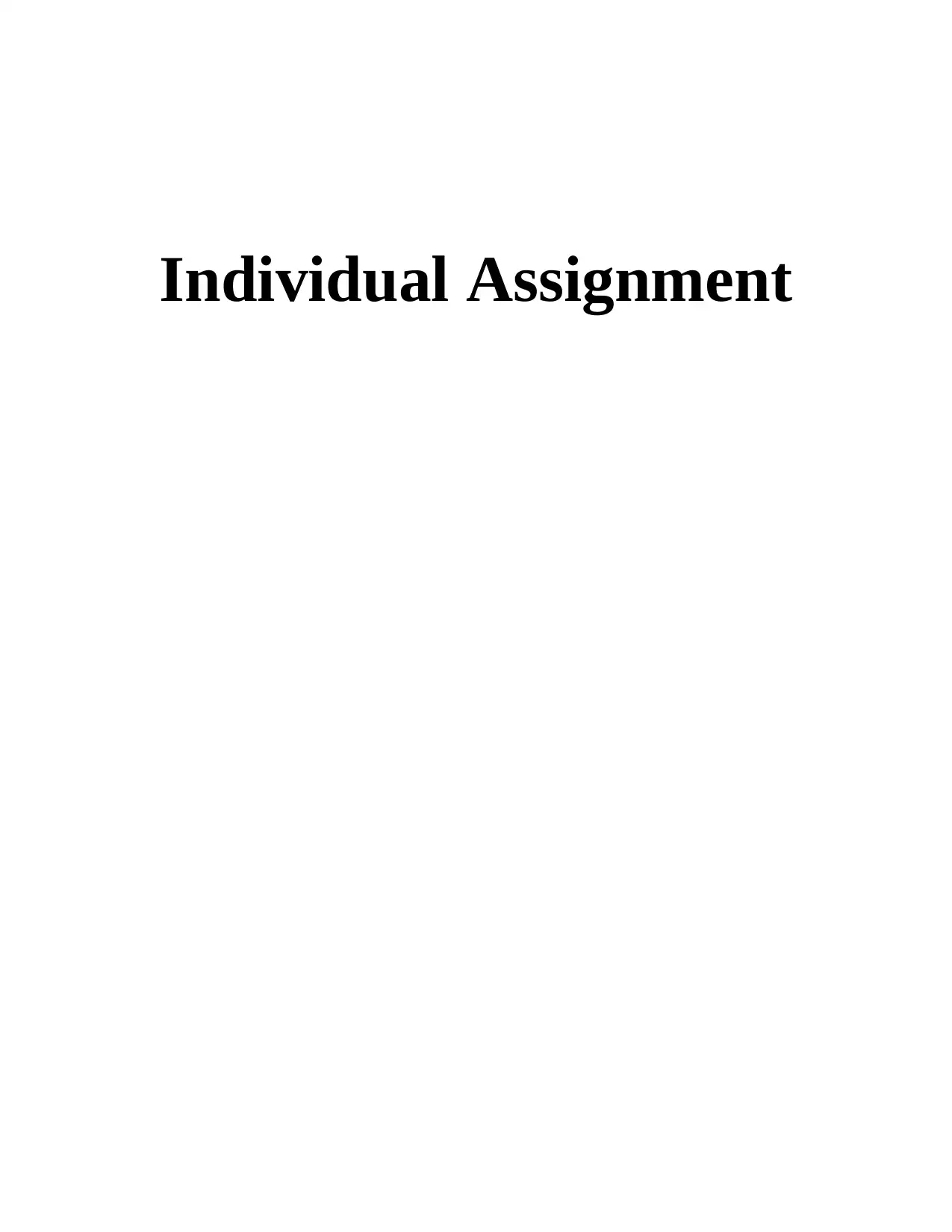
Individual Assignment
Paraphrase This Document
Need a fresh take? Get an instant paraphrase of this document with our AI Paraphraser

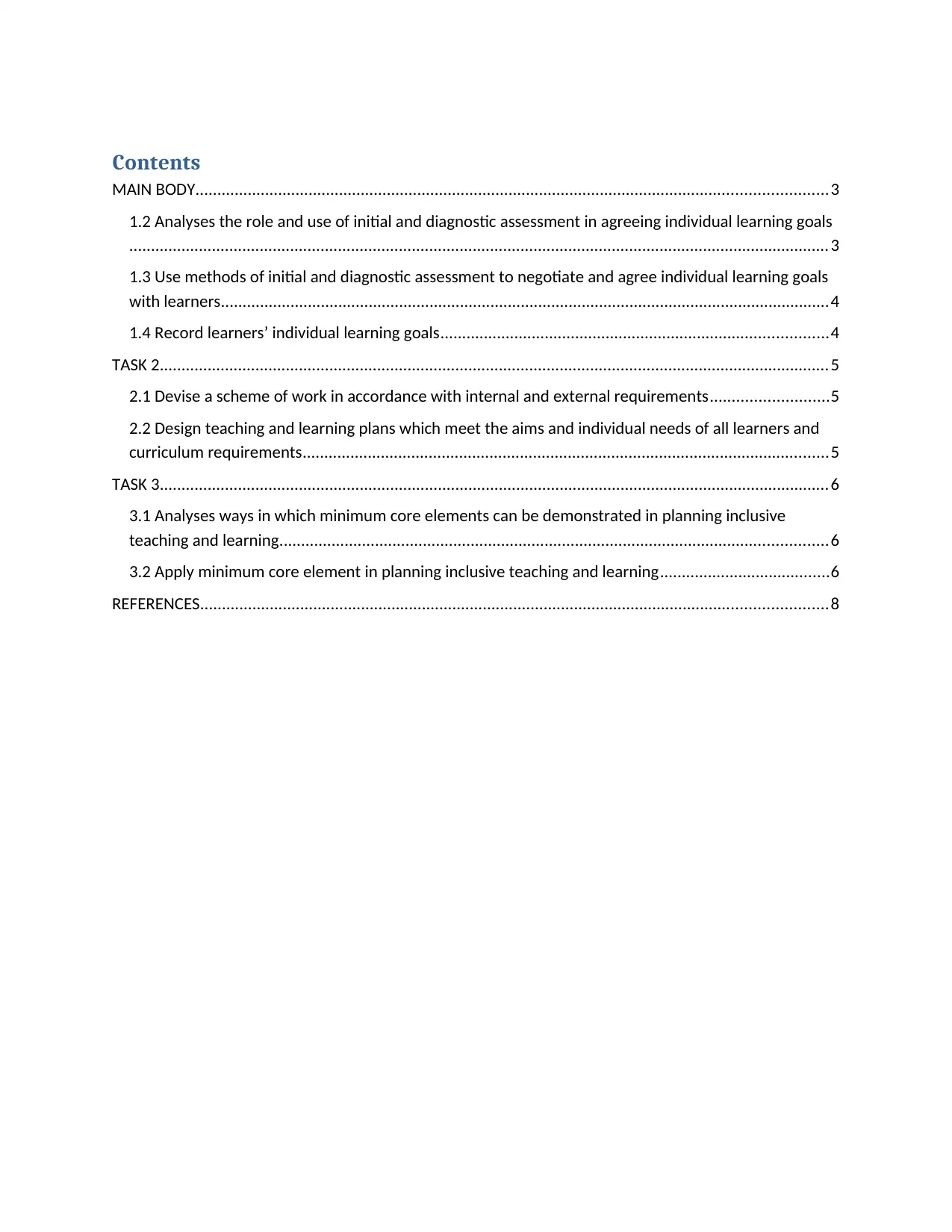
Contents
MAIN BODY.................................................................................................................................................3
1.2 Analyses the role and use of initial and diagnostic assessment in agreeing individual learning goals
.................................................................................................................................................................3
1.3 Use methods of initial and diagnostic assessment to negotiate and agree individual learning goals
with learners............................................................................................................................................4
1.4 Record learners’ individual learning goals.........................................................................................4
TASK 2..........................................................................................................................................................5
2.1 Devise a scheme of work in accordance with internal and external requirements...........................5
2.2 Design teaching and learning plans which meet the aims and individual needs of all learners and
curriculum requirements.........................................................................................................................5
TASK 3..........................................................................................................................................................6
3.1 Analyses ways in which minimum core elements can be demonstrated in planning inclusive
teaching and learning..............................................................................................................................6
3.2 Apply minimum core element in planning inclusive teaching and learning.......................................6
REFERENCES................................................................................................................................................8
MAIN BODY.................................................................................................................................................3
1.2 Analyses the role and use of initial and diagnostic assessment in agreeing individual learning goals
.................................................................................................................................................................3
1.3 Use methods of initial and diagnostic assessment to negotiate and agree individual learning goals
with learners............................................................................................................................................4
1.4 Record learners’ individual learning goals.........................................................................................4
TASK 2..........................................................................................................................................................5
2.1 Devise a scheme of work in accordance with internal and external requirements...........................5
2.2 Design teaching and learning plans which meet the aims and individual needs of all learners and
curriculum requirements.........................................................................................................................5
TASK 3..........................................................................................................................................................6
3.1 Analyses ways in which minimum core elements can be demonstrated in planning inclusive
teaching and learning..............................................................................................................................6
3.2 Apply minimum core element in planning inclusive teaching and learning.......................................6
REFERENCES................................................................................................................................................8
⊘ This is a preview!⊘
Do you want full access?
Subscribe today to unlock all pages.

Trusted by 1+ million students worldwide
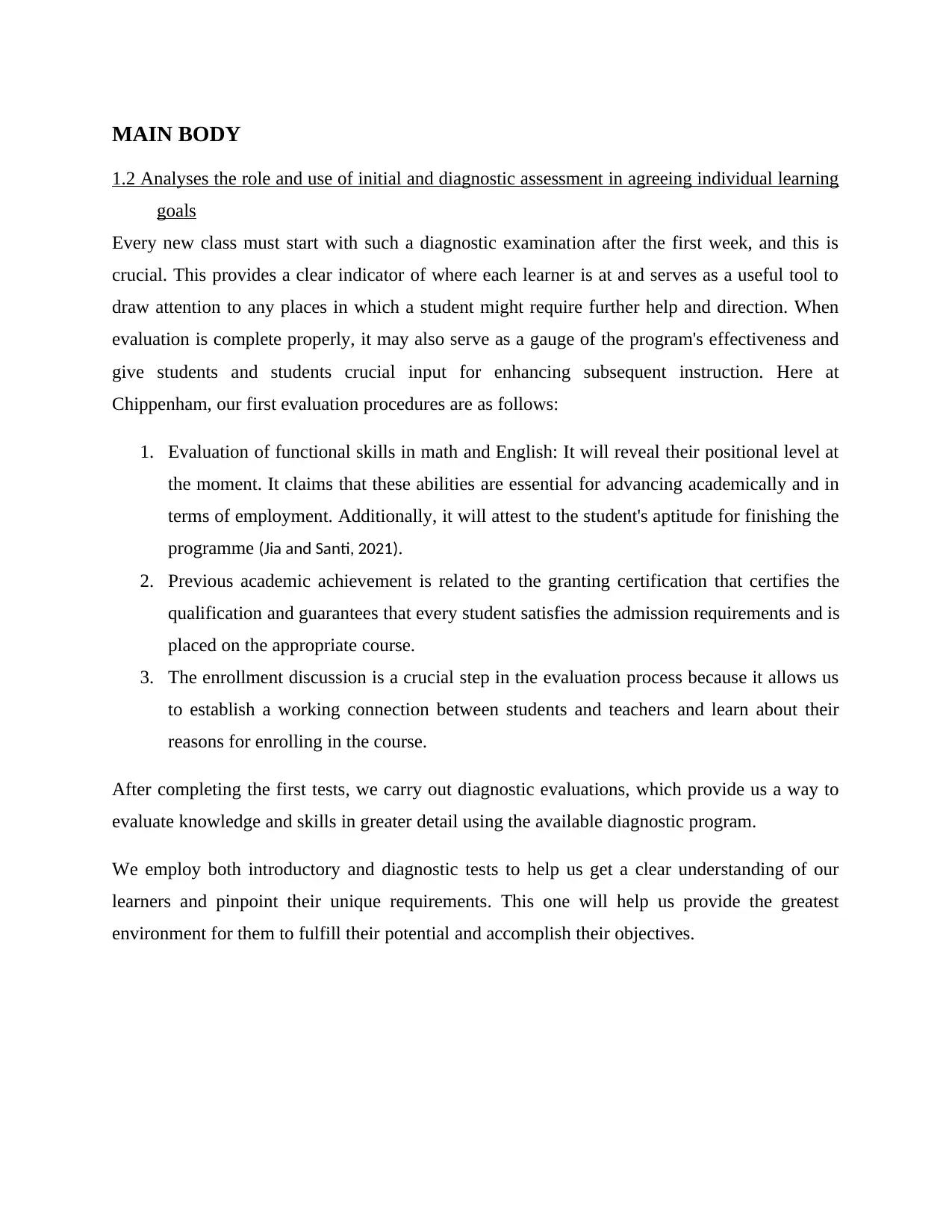
MAIN BODY
1.2 Analyses the role and use of initial and diagnostic assessment in agreeing individual learning
goals
Every new class must start with such a diagnostic examination after the first week, and this is
crucial. This provides a clear indicator of where each learner is at and serves as a useful tool to
draw attention to any places in which a student might require further help and direction. When
evaluation is complete properly, it may also serve as a gauge of the program's effectiveness and
give students and students crucial input for enhancing subsequent instruction. Here at
Chippenham, our first evaluation procedures are as follows:
1. Evaluation of functional skills in math and English: It will reveal their positional level at
the moment. It claims that these abilities are essential for advancing academically and in
terms of employment. Additionally, it will attest to the student's aptitude for finishing the
programme (Jia and Santi, 2021).
2. Previous academic achievement is related to the granting certification that certifies the
qualification and guarantees that every student satisfies the admission requirements and is
placed on the appropriate course.
3. The enrollment discussion is a crucial step in the evaluation process because it allows us
to establish a working connection between students and teachers and learn about their
reasons for enrolling in the course.
After completing the first tests, we carry out diagnostic evaluations, which provide us a way to
evaluate knowledge and skills in greater detail using the available diagnostic program.
We employ both introductory and diagnostic tests to help us get a clear understanding of our
learners and pinpoint their unique requirements. This one will help us provide the greatest
environment for them to fulfill their potential and accomplish their objectives.
1.2 Analyses the role and use of initial and diagnostic assessment in agreeing individual learning
goals
Every new class must start with such a diagnostic examination after the first week, and this is
crucial. This provides a clear indicator of where each learner is at and serves as a useful tool to
draw attention to any places in which a student might require further help and direction. When
evaluation is complete properly, it may also serve as a gauge of the program's effectiveness and
give students and students crucial input for enhancing subsequent instruction. Here at
Chippenham, our first evaluation procedures are as follows:
1. Evaluation of functional skills in math and English: It will reveal their positional level at
the moment. It claims that these abilities are essential for advancing academically and in
terms of employment. Additionally, it will attest to the student's aptitude for finishing the
programme (Jia and Santi, 2021).
2. Previous academic achievement is related to the granting certification that certifies the
qualification and guarantees that every student satisfies the admission requirements and is
placed on the appropriate course.
3. The enrollment discussion is a crucial step in the evaluation process because it allows us
to establish a working connection between students and teachers and learn about their
reasons for enrolling in the course.
After completing the first tests, we carry out diagnostic evaluations, which provide us a way to
evaluate knowledge and skills in greater detail using the available diagnostic program.
We employ both introductory and diagnostic tests to help us get a clear understanding of our
learners and pinpoint their unique requirements. This one will help us provide the greatest
environment for them to fulfill their potential and accomplish their objectives.
Paraphrase This Document
Need a fresh take? Get an instant paraphrase of this document with our AI Paraphraser
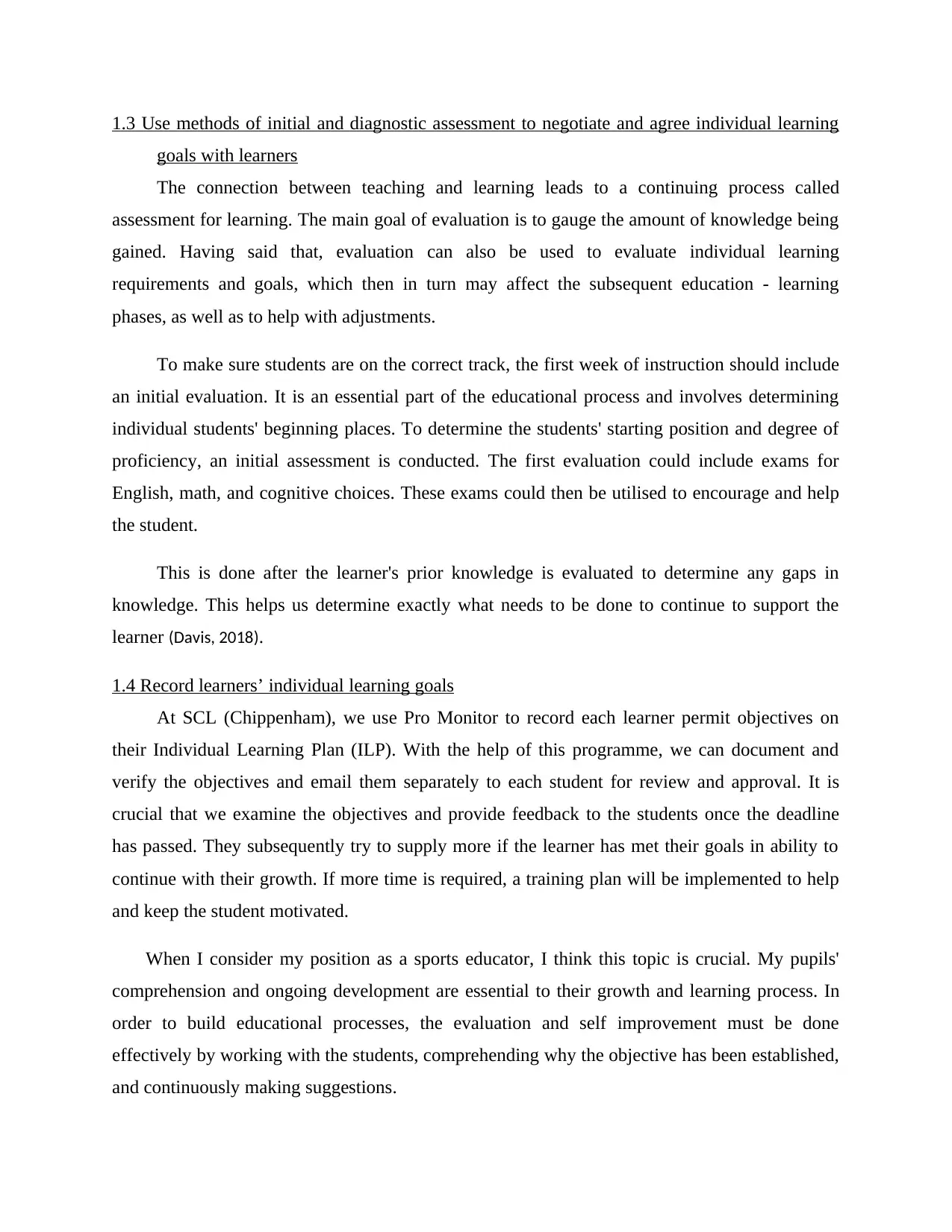
1.3 Use methods of initial and diagnostic assessment to negotiate and agree individual learning
goals with learners
The connection between teaching and learning leads to a continuing process called
assessment for learning. The main goal of evaluation is to gauge the amount of knowledge being
gained. Having said that, evaluation can also be used to evaluate individual learning
requirements and goals, which then in turn may affect the subsequent education - learning
phases, as well as to help with adjustments.
To make sure students are on the correct track, the first week of instruction should include
an initial evaluation. It is an essential part of the educational process and involves determining
individual students' beginning places. To determine the students' starting position and degree of
proficiency, an initial assessment is conducted. The first evaluation could include exams for
English, math, and cognitive choices. These exams could then be utilised to encourage and help
the student.
This is done after the learner's prior knowledge is evaluated to determine any gaps in
knowledge. This helps us determine exactly what needs to be done to continue to support the
learner (Davis, 2018).
1.4 Record learners’ individual learning goals
At SCL (Chippenham), we use Pro Monitor to record each learner permit objectives on
their Individual Learning Plan (ILP). With the help of this programme, we can document and
verify the objectives and email them separately to each student for review and approval. It is
crucial that we examine the objectives and provide feedback to the students once the deadline
has passed. They subsequently try to supply more if the learner has met their goals in ability to
continue with their growth. If more time is required, a training plan will be implemented to help
and keep the student motivated.
When I consider my position as a sports educator, I think this topic is crucial. My pupils'
comprehension and ongoing development are essential to their growth and learning process. In
order to build educational processes, the evaluation and self improvement must be done
effectively by working with the students, comprehending why the objective has been established,
and continuously making suggestions.
goals with learners
The connection between teaching and learning leads to a continuing process called
assessment for learning. The main goal of evaluation is to gauge the amount of knowledge being
gained. Having said that, evaluation can also be used to evaluate individual learning
requirements and goals, which then in turn may affect the subsequent education - learning
phases, as well as to help with adjustments.
To make sure students are on the correct track, the first week of instruction should include
an initial evaluation. It is an essential part of the educational process and involves determining
individual students' beginning places. To determine the students' starting position and degree of
proficiency, an initial assessment is conducted. The first evaluation could include exams for
English, math, and cognitive choices. These exams could then be utilised to encourage and help
the student.
This is done after the learner's prior knowledge is evaluated to determine any gaps in
knowledge. This helps us determine exactly what needs to be done to continue to support the
learner (Davis, 2018).
1.4 Record learners’ individual learning goals
At SCL (Chippenham), we use Pro Monitor to record each learner permit objectives on
their Individual Learning Plan (ILP). With the help of this programme, we can document and
verify the objectives and email them separately to each student for review and approval. It is
crucial that we examine the objectives and provide feedback to the students once the deadline
has passed. They subsequently try to supply more if the learner has met their goals in ability to
continue with their growth. If more time is required, a training plan will be implemented to help
and keep the student motivated.
When I consider my position as a sports educator, I think this topic is crucial. My pupils'
comprehension and ongoing development are essential to their growth and learning process. In
order to build educational processes, the evaluation and self improvement must be done
effectively by working with the students, comprehending why the objective has been established,
and continuously making suggestions.
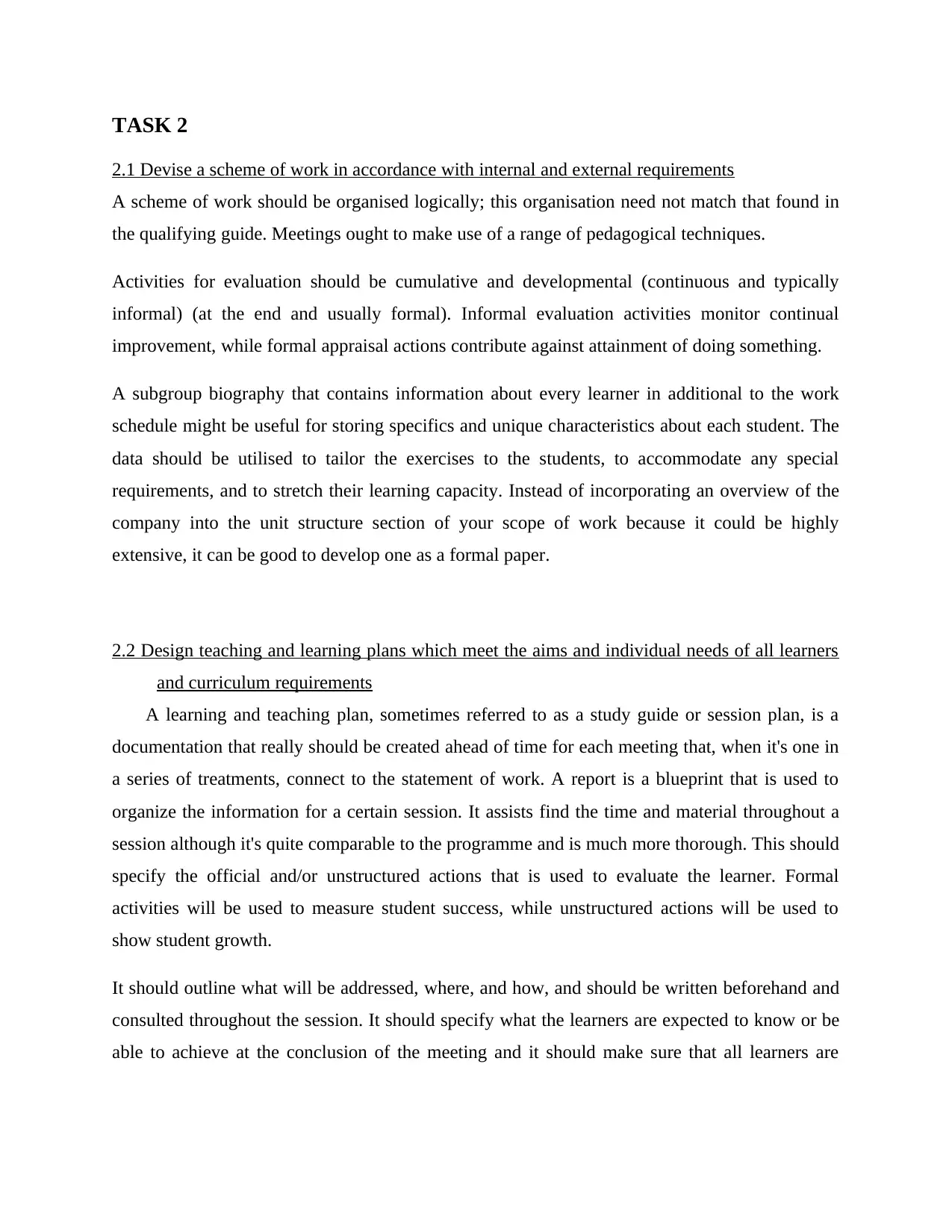
TASK 2
2.1 Devise a scheme of work in accordance with internal and external requirements
A scheme of work should be organised logically; this organisation need not match that found in
the qualifying guide. Meetings ought to make use of a range of pedagogical techniques.
Activities for evaluation should be cumulative and developmental (continuous and typically
informal) (at the end and usually formal). Informal evaluation activities monitor continual
improvement, while formal appraisal actions contribute against attainment of doing something.
A subgroup biography that contains information about every learner in additional to the work
schedule might be useful for storing specifics and unique characteristics about each student. The
data should be utilised to tailor the exercises to the students, to accommodate any special
requirements, and to stretch their learning capacity. Instead of incorporating an overview of the
company into the unit structure section of your scope of work because it could be highly
extensive, it can be good to develop one as a formal paper.
2.2 Design teaching and learning plans which meet the aims and individual needs of all learners
and curriculum requirements
A learning and teaching plan, sometimes referred to as a study guide or session plan, is a
documentation that really should be created ahead of time for each meeting that, when it's one in
a series of treatments, connect to the statement of work. A report is a blueprint that is used to
organize the information for a certain session. It assists find the time and material throughout a
session although it's quite comparable to the programme and is much more thorough. This should
specify the official and/or unstructured actions that is used to evaluate the learner. Formal
activities will be used to measure student success, while unstructured actions will be used to
show student growth.
It should outline what will be addressed, where, and how, and should be written beforehand and
consulted throughout the session. It should specify what the learners are expected to know or be
able to achieve at the conclusion of the meeting and it should make sure that all learners are
2.1 Devise a scheme of work in accordance with internal and external requirements
A scheme of work should be organised logically; this organisation need not match that found in
the qualifying guide. Meetings ought to make use of a range of pedagogical techniques.
Activities for evaluation should be cumulative and developmental (continuous and typically
informal) (at the end and usually formal). Informal evaluation activities monitor continual
improvement, while formal appraisal actions contribute against attainment of doing something.
A subgroup biography that contains information about every learner in additional to the work
schedule might be useful for storing specifics and unique characteristics about each student. The
data should be utilised to tailor the exercises to the students, to accommodate any special
requirements, and to stretch their learning capacity. Instead of incorporating an overview of the
company into the unit structure section of your scope of work because it could be highly
extensive, it can be good to develop one as a formal paper.
2.2 Design teaching and learning plans which meet the aims and individual needs of all learners
and curriculum requirements
A learning and teaching plan, sometimes referred to as a study guide or session plan, is a
documentation that really should be created ahead of time for each meeting that, when it's one in
a series of treatments, connect to the statement of work. A report is a blueprint that is used to
organize the information for a certain session. It assists find the time and material throughout a
session although it's quite comparable to the programme and is much more thorough. This should
specify the official and/or unstructured actions that is used to evaluate the learner. Formal
activities will be used to measure student success, while unstructured actions will be used to
show student growth.
It should outline what will be addressed, where, and how, and should be written beforehand and
consulted throughout the session. It should specify what the learners are expected to know or be
able to achieve at the conclusion of the meeting and it should make sure that all learners are
⊘ This is a preview!⊘
Do you want full access?
Subscribe today to unlock all pages.

Trusted by 1+ million students worldwide
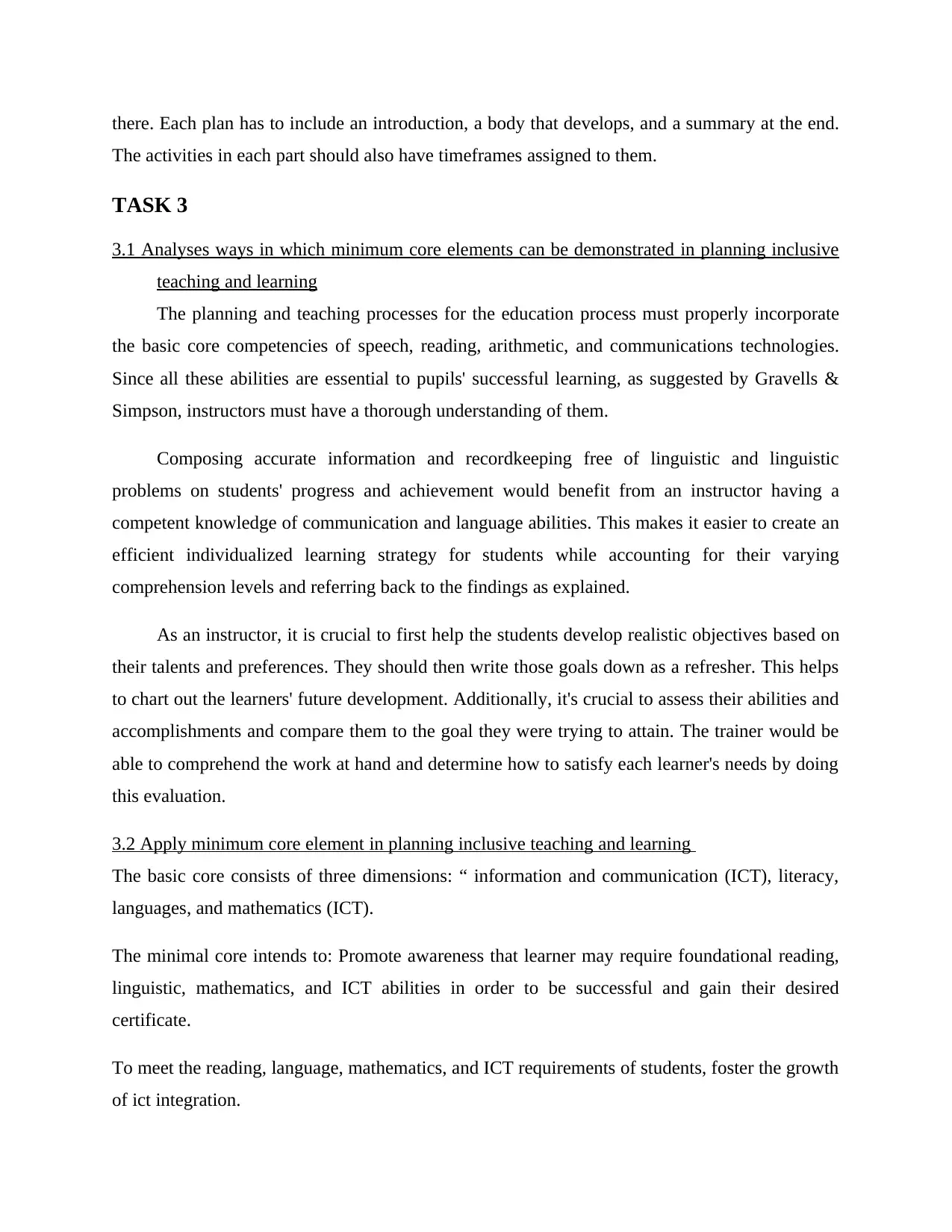
there. Each plan has to include an introduction, a body that develops, and a summary at the end.
The activities in each part should also have timeframes assigned to them.
TASK 3
3.1 Analyses ways in which minimum core elements can be demonstrated in planning inclusive
teaching and learning
The planning and teaching processes for the education process must properly incorporate
the basic core competencies of speech, reading, arithmetic, and communications technologies.
Since all these abilities are essential to pupils' successful learning, as suggested by Gravells &
Simpson, instructors must have a thorough understanding of them.
Composing accurate information and recordkeeping free of linguistic and linguistic
problems on students' progress and achievement would benefit from an instructor having a
competent knowledge of communication and language abilities. This makes it easier to create an
efficient individualized learning strategy for students while accounting for their varying
comprehension levels and referring back to the findings as explained.
As an instructor, it is crucial to first help the students develop realistic objectives based on
their talents and preferences. They should then write those goals down as a refresher. This helps
to chart out the learners' future development. Additionally, it's crucial to assess their abilities and
accomplishments and compare them to the goal they were trying to attain. The trainer would be
able to comprehend the work at hand and determine how to satisfy each learner's needs by doing
this evaluation.
3.2 Apply minimum core element in planning inclusive teaching and learning
The basic core consists of three dimensions: “ information and communication (ICT), literacy,
languages, and mathematics (ICT).
The minimal core intends to: Promote awareness that learner may require foundational reading,
linguistic, mathematics, and ICT abilities in order to be successful and gain their desired
certificate.
To meet the reading, language, mathematics, and ICT requirements of students, foster the growth
of ict integration.
The activities in each part should also have timeframes assigned to them.
TASK 3
3.1 Analyses ways in which minimum core elements can be demonstrated in planning inclusive
teaching and learning
The planning and teaching processes for the education process must properly incorporate
the basic core competencies of speech, reading, arithmetic, and communications technologies.
Since all these abilities are essential to pupils' successful learning, as suggested by Gravells &
Simpson, instructors must have a thorough understanding of them.
Composing accurate information and recordkeeping free of linguistic and linguistic
problems on students' progress and achievement would benefit from an instructor having a
competent knowledge of communication and language abilities. This makes it easier to create an
efficient individualized learning strategy for students while accounting for their varying
comprehension levels and referring back to the findings as explained.
As an instructor, it is crucial to first help the students develop realistic objectives based on
their talents and preferences. They should then write those goals down as a refresher. This helps
to chart out the learners' future development. Additionally, it's crucial to assess their abilities and
accomplishments and compare them to the goal they were trying to attain. The trainer would be
able to comprehend the work at hand and determine how to satisfy each learner's needs by doing
this evaluation.
3.2 Apply minimum core element in planning inclusive teaching and learning
The basic core consists of three dimensions: “ information and communication (ICT), literacy,
languages, and mathematics (ICT).
The minimal core intends to: Promote awareness that learner may require foundational reading,
linguistic, mathematics, and ICT abilities in order to be successful and gain their desired
certificate.
To meet the reading, language, mathematics, and ICT requirements of students, foster the growth
of ict integration.
Paraphrase This Document
Need a fresh take? Get an instant paraphrase of this document with our AI Paraphraser
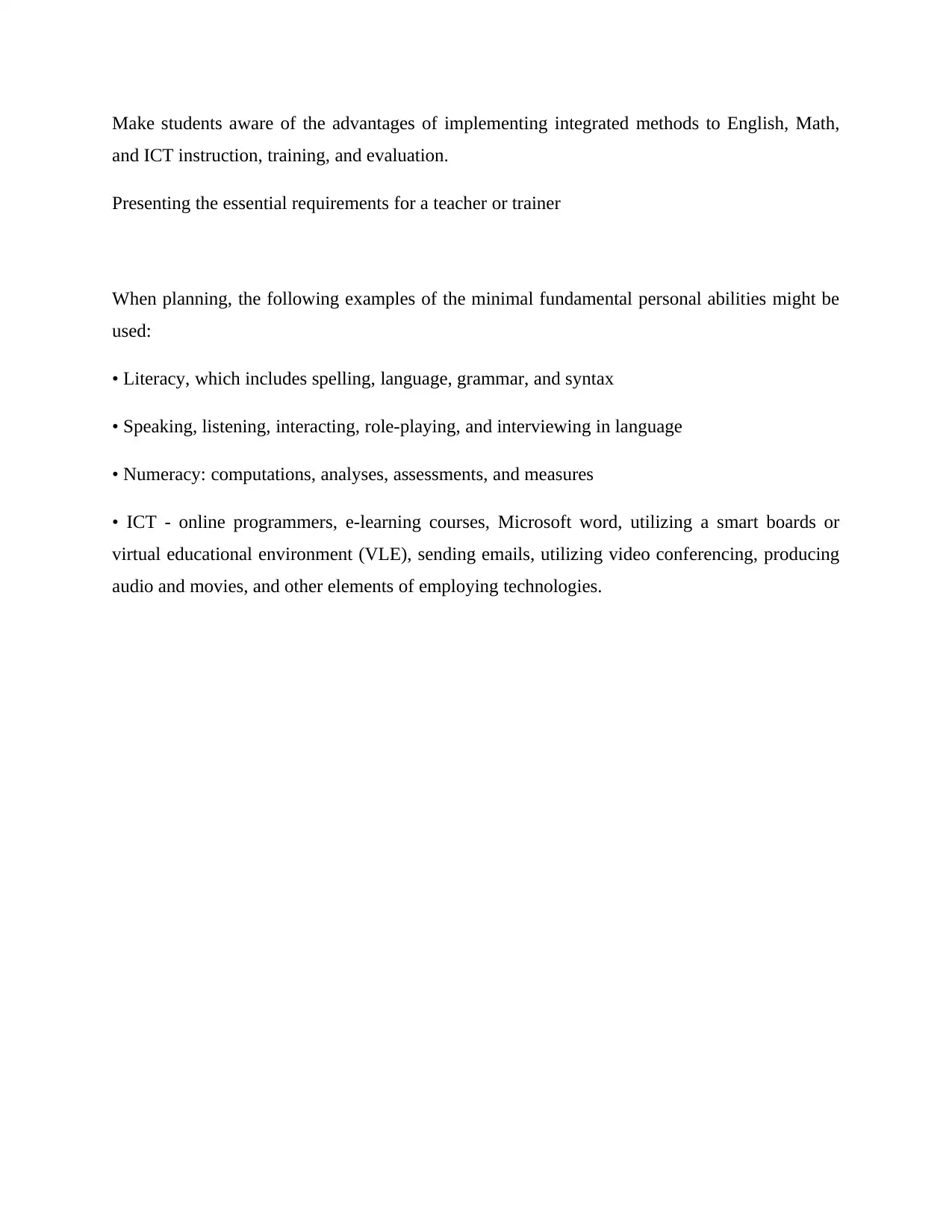
Make students aware of the advantages of implementing integrated methods to English, Math,
and ICT instruction, training, and evaluation.
Presenting the essential requirements for a teacher or trainer
When planning, the following examples of the minimal fundamental personal abilities might be
used:
• Literacy, which includes spelling, language, grammar, and syntax
• Speaking, listening, interacting, role-playing, and interviewing in language
• Numeracy: computations, analyses, assessments, and measures
• ICT - online programmers, e-learning courses, Microsoft word, utilizing a smart boards or
virtual educational environment (VLE), sending emails, utilizing video conferencing, producing
audio and movies, and other elements of employing technologies.
and ICT instruction, training, and evaluation.
Presenting the essential requirements for a teacher or trainer
When planning, the following examples of the minimal fundamental personal abilities might be
used:
• Literacy, which includes spelling, language, grammar, and syntax
• Speaking, listening, interacting, role-playing, and interviewing in language
• Numeracy: computations, analyses, assessments, and measures
• ICT - online programmers, e-learning courses, Microsoft word, utilizing a smart boards or
virtual educational environment (VLE), sending emails, utilizing video conferencing, producing
audio and movies, and other elements of employing technologies.
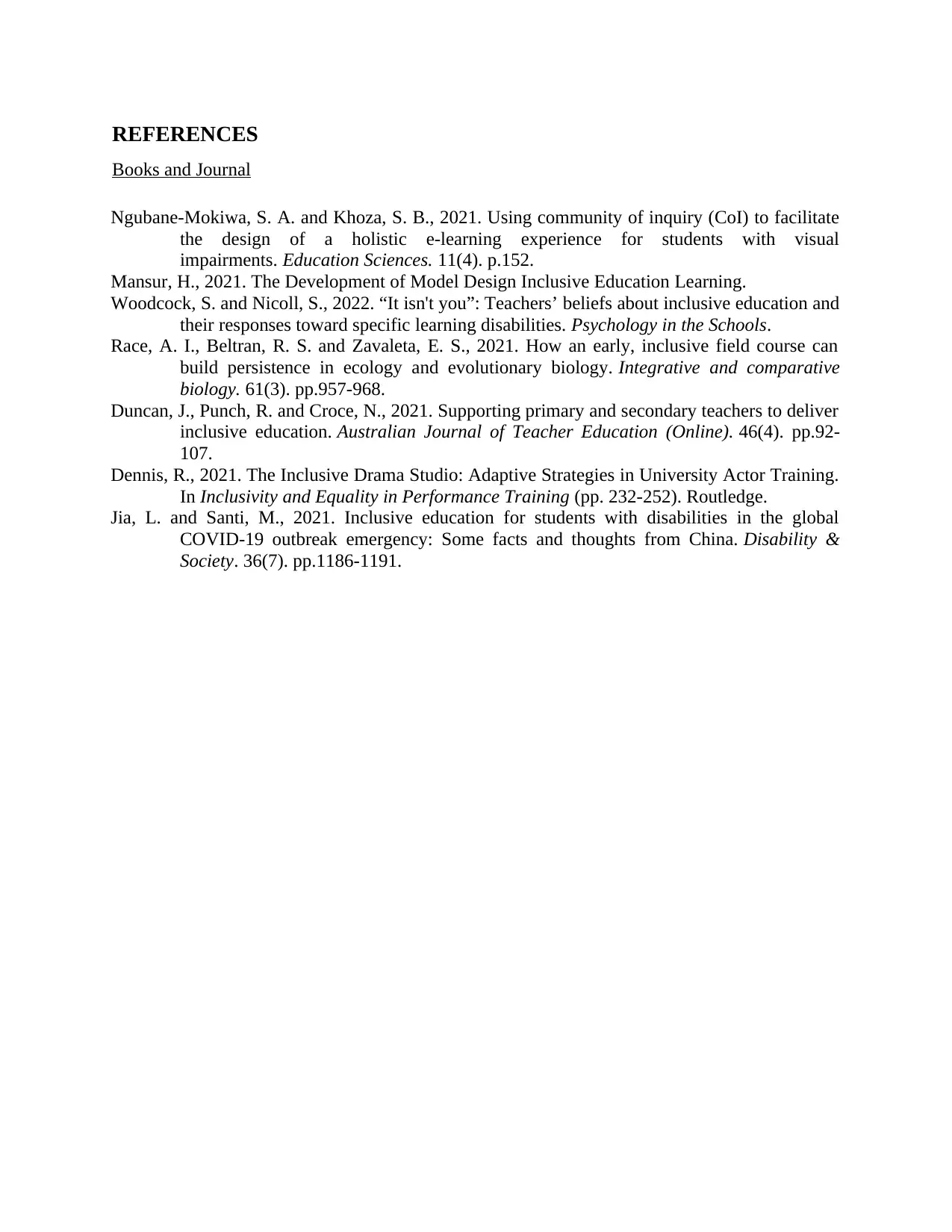
REFERENCES
Books and Journal
Ngubane-Mokiwa, S. A. and Khoza, S. B., 2021. Using community of inquiry (CoI) to facilitate
the design of a holistic e-learning experience for students with visual
impairments. Education Sciences. 11(4). p.152.
Mansur, H., 2021. The Development of Model Design Inclusive Education Learning.
Woodcock, S. and Nicoll, S., 2022. “It isn't you”: Teachers’ beliefs about inclusive education and
their responses toward specific learning disabilities. Psychology in the Schools.
Race, A. I., Beltran, R. S. and Zavaleta, E. S., 2021. How an early, inclusive field course can
build persistence in ecology and evolutionary biology. Integrative and comparative
biology. 61(3). pp.957-968.
Duncan, J., Punch, R. and Croce, N., 2021. Supporting primary and secondary teachers to deliver
inclusive education. Australian Journal of Teacher Education (Online). 46(4). pp.92-
107.
Dennis, R., 2021. The Inclusive Drama Studio: Adaptive Strategies in University Actor Training.
In Inclusivity and Equality in Performance Training (pp. 232-252). Routledge.
Jia, L. and Santi, M., 2021. Inclusive education for students with disabilities in the global
COVID-19 outbreak emergency: Some facts and thoughts from China. Disability &
Society. 36(7). pp.1186-1191.
Books and Journal
Ngubane-Mokiwa, S. A. and Khoza, S. B., 2021. Using community of inquiry (CoI) to facilitate
the design of a holistic e-learning experience for students with visual
impairments. Education Sciences. 11(4). p.152.
Mansur, H., 2021. The Development of Model Design Inclusive Education Learning.
Woodcock, S. and Nicoll, S., 2022. “It isn't you”: Teachers’ beliefs about inclusive education and
their responses toward specific learning disabilities. Psychology in the Schools.
Race, A. I., Beltran, R. S. and Zavaleta, E. S., 2021. How an early, inclusive field course can
build persistence in ecology and evolutionary biology. Integrative and comparative
biology. 61(3). pp.957-968.
Duncan, J., Punch, R. and Croce, N., 2021. Supporting primary and secondary teachers to deliver
inclusive education. Australian Journal of Teacher Education (Online). 46(4). pp.92-
107.
Dennis, R., 2021. The Inclusive Drama Studio: Adaptive Strategies in University Actor Training.
In Inclusivity and Equality in Performance Training (pp. 232-252). Routledge.
Jia, L. and Santi, M., 2021. Inclusive education for students with disabilities in the global
COVID-19 outbreak emergency: Some facts and thoughts from China. Disability &
Society. 36(7). pp.1186-1191.
⊘ This is a preview!⊘
Do you want full access?
Subscribe today to unlock all pages.

Trusted by 1+ million students worldwide
1 out of 9
Related Documents
Your All-in-One AI-Powered Toolkit for Academic Success.
+13062052269
info@desklib.com
Available 24*7 on WhatsApp / Email
![[object Object]](/_next/static/media/star-bottom.7253800d.svg)
Unlock your academic potential
Copyright © 2020–2025 A2Z Services. All Rights Reserved. Developed and managed by ZUCOL.
